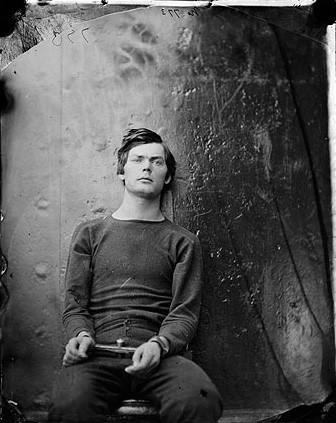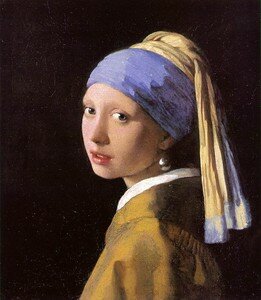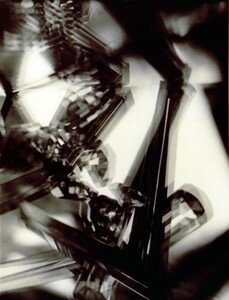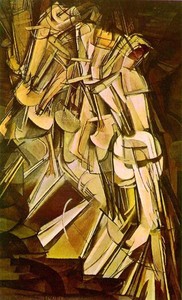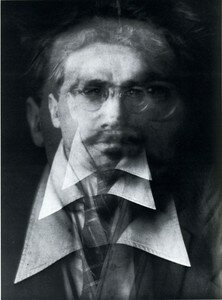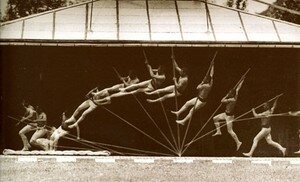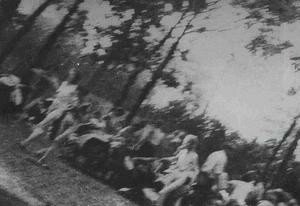Paradoxically, it seems that while photographers
were conforming to a pictorial vision, as Cameron did, they were at the same
time calling it into question as they were essentially questioning the
relationship between photography and painting. The British landscape
photographers George Davison (1854-1930) and Alfred Horsley Hinton (1863-1908)
sought to assert their distinctive photographic identity. Later they came to be
associated with the photographic and aesthetic movement called Pictorialism.
II. A. 2. a) George Davison: a naturalistic and
impressionist use of the blur
Both photographers instilled
impressionist and ethereal atmospheric effects in their pictures and both of
them worked on landscapes as their major subjects. As Davison stated in his
paper to The British Journal of Photography
in September 1889,
“It is not in man,
even in f.64 man, to overlook the unnaturalness of joinings in photographic
pictures, and the too visible drawing-room drapery air about attractive ladies
playing at haymaking and fishwives.”
Davison was in
agreement with Peter Henry Emerson’s rejection of Cameron’s pictorial portraits.
However, he did appreciate Oscar G. Rejlander and Henry Peach Robinson’s work
on prints made up of pieces of different negatives. He was against Robinson’s
main idea that the essential characteristic of photography was the use of focus
in order to achieve complete accuracy and sharpness. He also followed the steps
of Emerson and his theories upon photography which favoured a naturalistic
point of view on subjects, usually preferring taking picture of landscapes,
rural and seaside scenes.
Nevertheless,
Davison chose a different path concerning the use of focus. He preferred a
general soft focus rather than Emerson’s idea of a selected focus to set a
general idea of nature. He wrote in 1891 that “plus la photographie se révèle capable de
traduire une appréhension directe de la nature, plus elle peut influer sur la
sensibilité esthétique“.
In order to reach
this idea, he used a pinhole camera to produce soft focus pictures. One of his achievements
is the picture entitled The Onion Field
of 1889. The picture depicts an isolated farm which stands behind a vast onion
field. The human presence is introduced with smoke going out of a chimney and some
washing hanging out in the courtyard.
Opposing contrasts,
from the dark areas of the forest behind the farm to the foot of the onion
field in the foreground and light areas marked by the top of each single plant
of onion, one of the roofs of the houses which compose the farm, the drying
clothes and the sky, the overall image gives a feeling of light reflecting
differently, bringing out the shades of light, but largely absorbed by the
landscape.


George Davison, The Onion Field,
1889
The picture
presents all the characteristics of impressionism. The perspective is flattened
by the use of soft focus due to the absence of lens in the pinhole camera.
Nothing in particular stands out. We are more under the “impression” of a
general landscape since the onion field mingles with the old farm situated in
the background. Accuracy of figures, though distinguishable, disappears to the
benefit of a “sensitive” apprehension on the general landscape. Davison
captured and emphasized the essence of the subject rather than its
details.
The Onion Field is
closer to the memory of an onion field rather than an accurate representation
of an onion field. Soft focus establishes the idea that what matters the most is not the
onion field itself but “the idea of an onion field”. Talking about pinhole cameras, Michel
Imbert said, “C’est le cerveau qui voit, ce n’est pas
l’oeil”.
This idea is
confirmed by the absence of lens, which usually stands for the human eye in the
optical mechanism of a camera. Therefore, the information given - a field of
onions - is interpreted by the pinhole camera - a fuzzy field of onion - which
can be compared to the human perception. It reinforces the fact that seeing is
always an interpretation. As Michel Imbert
put it,
“ Quand je regarde le monde qui m’entoure, je le
regarde avec mes yeux, c’est à dire mes désirs, mes craintes, mes propres
idées, mais lorsque je le regarde tel que représenté sur une photographie,
c’est à travers les yeux et l’esprit du photographe qu’il m’apparaît.“
The impressionist
photograph by Davison emphasizes his interpretation of a rural scene. A focused
representation of that onion field would have been a basic representation of an
onion field but the use of soft focus shows the idea of going beyond strict
reality, pure description or the science of appearances. Citing impressionist painters like Claude
Monet, Davison emphasizes the human perception of the real, in opposition to a
strict depiction of the real. He allows representation to go back to its
source. That is to say that, in representation, whether it is photographic or
pictorial representation, the major interest is not the real – the subject –
but what we understand of it and how we perceive it.
II. A. 2. b) Alfred Horsley Hinton: a purely
impressionist use of the blur
In the same way,
Alfred Horsley Hinton only focused on impressionist landscapes. Though he died
quite young, aged 45, he is one of the most brilliant landscape photographers
of English pictorial photography. Unlike Davison, he did not care about making
a direct print and liked to work on negatives. He usually composed his
photographs by working on several negatives, assembling them – what Davison mentioned
as “unnatural joinings”
- and often drew on them. In the end, he obtained one single and original
print. He was probably taught by Ralph Robinson, the son of Henry Peach
Robinson when he was working at Robinson’s workshop at the beginning of the
1890s.

Alfred Horsley Hinton, Hymn, 1895 – Fig. 1
All of his
landscapes are English landscapes and his particular feature was to entitle his
photographs allegorically. His photographs Fleeting
and Far, Beyond and Rain from the Hills were both published in 1905 in Alfred
Stieglitz’s revue Camera Work
(1903-1917).
Hinton ran the London
revue Amateur Photographer and
supported pictorial photography until his death in 1908. His passion for
pictorial and impressionist photography reveals itself in his photograph Hymn taken in 1895 (fig. 1).
A pond, surrounded
by a forest in the background and a moor in the foreground, reflects the light
of a cloudy sky. Some dark and light areas from the sky echo in the pond. A row
of trees makes the transition between the earth and the sky.


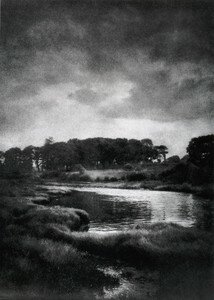

Gustave Le Gray, La Grande Vague, Sète, 1857 - Fig. 2
To study Alfred Horsley
Hinton’s picture, I would like to compare it to one of Gustave Le Gray’s
photograph he did in 1857 called La
Grande Vague.
Interestingly
enough, French photographer Gustave Le Gray (1820-1884) and Alfred Horsley
Hinton were both trained as painters and became photographers. Both pictures
associate two elements. The sky takes as much importance as the earth (fig. 1)
or the sea (fig. 2). We can recall Turner’s paintings when we observe the sky
of these pictures. Both skies are luminous and dramatic and reflect the watery
elements. Both photographers worked on two separate negatives, one for the sky
and one for the earth.
What is blurred in
Le Gray’s picture is the motion of the wave splashing the rocks, whereas in
Hinton’s it is the vegetation. In both pictures, we can sense the action of the
wind which is implied by the dramatic sky. If Le Gray faces a big wave, as the
title of his picture suggests, Hinton’s pond shows wavelets on its edge. It is
interesting how the slight blur of each picture is linked to the notion of motion
and time of exposure. In Hinton’s landscape, it gives a dreamy and impressionist
idea of a British landscape whereas in Le Gray’s picture, it emphasizes the
very action of the wave splashing the rocks of the quayside at the city of
Sète.



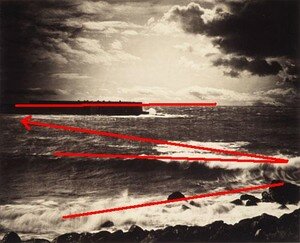
Besides, the
structure of both pictures is very similar. The skyline is broken by the forest
in Hinton’s (fig. 1) and by the dock in Le Gray’s (fig. 2). If we compare the
lines of sight, we can see that they both start from the bottom of the right hand
side of the picture and point to the middle left hand side. In the foreground,
the row of rocks (fig. 2) echoes to the line of the moor (fig. 1). Parallels
can be drawn between rocks and the dock (fig; 2) and the beginning of the pond
and the background forest (fig. 1).
As for the titles
of the pictures, Gustave Le Gray’s seascape has got a descriptive title whereas
Alfred Horsley Hinton entitled his picture Hymn.
This may refer to what the landscape recalls to him. Hinton chose an evocative
caption, drawing an interpretation of his subject. Le Gray chose a descriptive one.
While Le Gray’s picture only refers to itself, Hinton’s approach of the
landscape invites us to reflect upon another image, picture or sound we have in
mind, drawing a line between photography and history of art or photography and
music for instance.
Thirty-eight years
after The Great Wave by Gustave Le
Gray, photography had evolved, experiencing new techniques and visions among
those who practised it. Neither picture is more beautiful or artistic than the
other but they demonstrate a different approach to photography. Impressionist
vision is what characterised Hinton and Davison’s landscapes. They deeply
related to the artistic trend of the end of the 19th century, and in
particular to painting with the Impressionist movement. It is quite interesting
to notice that it was French photographer Nadar who first presented the
Impressionist painters in his workshop, boulevard des Capucines, in 1874.
Michel Imbert,
« C’est le cerveau qui voit, ce n’est pas l’œil », p.55, quoted in Jean-Marie Baldner & Yannick Vigouroux, Les Pratiques Pauvres, du sténopé au téléphone mobile, Paris,
Isthme éditions, 2005
B. The
Theoretical Blur
With regard to the focus debate, Peter Henry
Emerson was the first photographer to support and draw up a theory out of the
use of a partial blur. He developed an aesthetic vision that he claimed was naturalistic.
After Cameron’s spiritual blur and Davison and Hinton’s impressionist
fuzziness, Emerson threw himself into pictorial photography which he proposed
to redefine.
II. B. 1. a) Peter Henry Emerson:
a scientific approach of pictorial photography
Peter Henry Emerson (1856-1936) was a brilliant
medical student who abandoned his career as a physician for the sake of
photography. He sought a scientific founding to art photography, and made a
dashing and revolutionary entrance in the photographic world when, as an
introduction to his aesthetic approach of what photography should be, he harshly
criticized all the emblematic figures of pictorial photography and
pre-Raphaelites.
In his lecture to The Camera Club of London, in March 11, 1886, though unnamed, he
referred to art critic John Ruskin, who influenced pictorial photographers like
Cameron and Rejlander, in those terms:
“One of these spasmodic elegants of Art
literature has made it a point to scoff at any connexion between science and
Art, and has flooded the world, in beautiful writing in which his power lies,
with dogmatic assertions and illogical statements.”
In the same way, he was not afraid to target photographer
Henry Peach Robinson’s book, entitled Pictorial
Effect in Photography (1869),
“a senseless jargon of quotations from literary
writers on Art matters, a confused bundle of lines which take all sorts of
ridiculous directions (…) contain[ing] the quintessence of a blend of literary
fallacies and Art anachronism”
Having
established his full disagreement with former pictorial photography, and
adopting the ideas of Hermann von Helmholtz, who explored the mechanics of
human vision, Emerson tried to find a new base to photography. He said, “we
[photographers] can never equal painting; but all other branches of pictorial
Art we are able to surpass”. “Painting alone”, he continued, “is our master”. His whole point was to represent
as true as possible the impression of Nature on the human eye. The real was
supplanted by the perception of the real. His approach was called naturalistic.
To
reach this idea of a naturalistic approach, he advised photographers to go
outside their studios and workshops and photograph real people in their natural
environment. He dismissed the contrived and posing costumed models of Victorian
society.
As regards the use of focus, Emerson explained
his views in his book, Naturalistic
Photography for Students of the Art, twenty years after Robinson’s, in
1889. He advised a focus with judgement, a slight out of focus,
“not [to] be carried to the length of
destroying the structure of any object, otherwise it becomes noticeable, and by
attracting detracts from the harmony, and is then just as harmful as excessive
sharpness would be. (…) Nothing in nature has a hard outline, but everything is
seen against something else, and its outlines fade gently into that something
else, often so subtlety that you cannot quite distinguish where one ends and
the other begins. In this mingled decision and indecision, this lost and found,
lies all the charm and mystery of nature.”
His
textbook was described as “a bombshell dropped in a tea party” and resulted in much
criticism. Robinson claimed that “healthy human eyes never saw any part of a
scene out of focus”. And Emerson replied “I
have yet to learn that any one statement or photograph of Mr. H. P. Robinson
has ever had the slightest effect upon me except as a warning of what not to
do.” As a result, some
photographers followed Emerson’s point of view on out of focus and started to
shoot soft focus photographs, sarcastically called by others “fuzzygraphs”.
The debate over focus was a very tricky and
impassioned one in 19th century British photography. Emerson had
made a vehement protest against the former genre of pictorial photography, yet
the photographical world continued to subscribe to a pictorial composition as
the photographs of the period remained very similar in framing and composition
to painting. The combination of these
two factors initiated a new way of making picture. Emerson’s style stands
in-between pure photography – or ‘straight photography’ as Sadakichi Hartmann stated
- and pictorial photography.
II. B. 1. b) Peter Henry Emerson: the obsession of
focusing like the eye
In my study of Emerson’s naturalistic
fuzziness, I will compare his photograph entitled A Stiff Pull (1888) to Jean François Millet’s painting called Les Glaneuses (1857) presented in the Musée
d’Orsay.

Peter Henry Emerson, A Stiff Pull, 1888

Jean-François Millet, Les Glaneuses, 1857
Jean François Millet (1814-1875) was one of
Emerson’s big influences. He actually referred to him in is Photography, A Pictorial Art among other
painters such as John Constable (1776-1837) and Camille Corot (1796-1875). As a
matter of fact, Millet and Corot’s work had been exhibited in London in the
1870s.
A
Stiff Pull was published in the
book Pictures of East Anglian Life in
1888 and presented a lot of folkloristic studies. Two horses are dragging a
plough while a farmer is digging a furrow in fallow land. Gravel is scattered
over the surface. A cloudy sky opposes the sloping ground in equal proportion. The
scene is taken from behind. The horses stand in the centre whereas the ploughman,
who is wearing a hat, lies in the foreground on the left hand side of the
picture.
In
Jean François Millet’s picture, Les
Glaneuses, gestures and details in the picture are absorbed in the action.
The hands and face of the female gleaners are coarse and roughly done. Their
shoes almost merge with the colour of the land. In the same way, the colour and
shades of the sky reminds the brown and yellow tones of the field. A feeling of
blur and lack of accuracy prevail.
Similarly, a general look at Emerson’s picture shows
that it does not give any sharp vision of the rural scene he photographed. The
horses and the top of the ploughman’s body stand out of the skyline level but
the overall greyness of the ground corrupts the living elements. In his effort,
the ploughman seems disproportionate and deformed. Besides, the motion of the
effort sets the general fuzziness of his body.
However,
a closer look at Emerson’s pictorial picture may change our first impression. In
spite of a general soft focus, some parts appear to be focused and sharp. In
fact, if the left leg is blurred by the pull of traction, the other one, the
stiff one as the title says, is sharply focused. Even if it is difficult to
distinguish the ploughman’s right shoe, deepened in the gravelled ground, we
can observe that around this shoe all the ground and stones are totally focused.
Therefore, Peter Henry Emerson, through the title of his photograph, pointed
out the area that the viewer should look. With the caption, he actually indicated
where the viewer should in turn focus.
In The
Amateur Photographer, January 1890, D. Habord described the picture as
such,
“An awful abortion representing a man plowing
up-hill with a pair of horses. The man’s foot was as long as the horse’s head
and the whole picture was gloriously so ‘naturalistic’, i.e., ‘fuzzy’ or
‘focused with judgement’ that it was denounced as an imposture.”
Nonetheless, the plate received a silver medal at The Amateur Photo Exhibition in London in 1886.
Setting the pictures of Emerson in the history of
photography, he appears as a pioneer photographer. Although he abandoned his
beliefs that photography was an art in 1891, after he was told by scientists
that control of tones by development was impossible, he was the first
photographer to have linked up science and art, the document and art
photography. With his care of a naturalistic subject, framing and hypothesis on
what focus should be, he seemed to have brought in the very beginnings of
social photography.
In
his ideal of representation, Emerson tried to gather both the Truth and the
Beautiful, as Baudelaire opposed in these terms two contradictory aspects of
art in his speech of the Salon des Beaux-Arts of 1859. A true representation was
achieved by the choice of subjects and a beautiful one thanks to the art of the
photographer. Following the tradition of pictorial art, a concern in framing,
the rendering of the light in its shaded tones (Photography, a Pictorial Art) and through the use of blur Emerson
banished the idea of a commercial photography and its primary function as a
document.
In the 1880s, through on-going debates and
discussions upon the use of blur, photography had reached the status of art in
photographers’ mind. Painting and photography were easily comparable and similarities
were drawn between the two. Photography little by little had gained
credibility. Now sharing a mutual ground with painting, through combining aesthetic and mastery, photography was
waiting for its independence and recognition from a larger audience. Even
though photographs had been exhibited since the very beginning of the 1850s and
photographic societies flourished, photographers wanted to offer their art a
‘room of its own’, to borrow Virginia Woolf’s words in another context. As
such, a group of photographers decided to set an example and ventured into the
prospect of photography as an art.
II. B. 2. a) The Linked Ring
Brotherhood: a showcase to blurred photographs
In 1888, the first hand camera was released on
the market by George Eastman’s company Kodak. A year later, photographic film was
made of celluloid and mass produced. A new photographic industry developed and
specialized in processing film rolls and printing. Consequently, there was no more
need to have a special room in the house dedicated to photography, no need to
manipulate and buy expensive chemicals or glass plates and no need to possess
knowledge to make meticulous hand-prints. It was thus a major breakthrough in
the evolution of photography. These great improvements introduced a new
approach in framing pictures and allowed photographers to explore their
environment, leading at the beginning of the 20th century to
documentary and street photography. As a result, a larger population could now
access photography; a population which, on the whole, held no regard for
photography as an art.
Owing to the fact that photography was now
available to a new social class, it was no more the privileged pastime of a
certain elite called the amateur photographers. More and more images were being
produced, sold and reproduced. More and more photographs illustrated newspapers
for example. In view of the democratisation and industrialization of the medium
and out of fear that good taste and art would be crushed by popularization,
some amateur photographers distanced themselves and got together to discuss representation
and art photography.
In 1891, the first exhibition of art
photography took place in Vienna. It was initiated by the German photographic
society Kamera Club. Some British amateur photographers from the Royal
Photographic Society, who felt disenchanted and oppressed by the majority of
photographers who were basically technologist photographers, complained that
their work was not recognized and decided to break away and form their own
collective.
With regard to the American Civil War of the
1860s, they later claimed themselves to be photo-secessionists, as American
Alfred Stieglitz’s speech suggested in 1903.
Alfred Stieglitz claimed that the
photo-secession was accomplished
“(…) to register their [photographers] protest
against the reactionary spirit of the masses. This protest, this secession from
the spirit of the doctrinaire, of the compromiser, at length found its
expression in the foundation of the Photo-Secession. Its aim is loosely to hold
together those Americans devoted to pictorial photography in their endeavour to
compel its recognition, not as the hand-maiden of art, but as a distinctive
medium of individual expression.”
Under the impulse of Alfred Maskell, British ‘secessionists’
assembled and founded the Linked Ring Brotherhood in 1892. This new society, whose
founder members were Alfred Maskell, H. P. Robinson, Lionel Clark, George
Davison, Henry Hay Cameron (Julia Margaret Cameron’s son) and Alfred Horsley
Hinton, declared itself to be the standard bearer of art photography in
England. The name of the Linked Ring was chosen to symbolize the unity of its
members.
The Linked Ring Brotherhood welcomed
international photographers who had also broken away from the mainstream -
seceded - and adopted new members such as British photographers Frederick
Evans, Alvin Langdon Coburn and Frank M. Sutcliffe; American Baron Adolf De Meyer,
Alfred Stieglitz, Edward J. Steichen, Gertrude Käsebier and Clarence H. White;
French Robert Demachy and Constant Puyo; and German Heinrich Kühn, and Theodor
and Oscar Hofmeister.
To promote art photography, the aims of the
Linked Ring were threefold. First, they held annual exhibitions from 1893 to
1909. They called them “salons”, a name deliberately borrowed from the world of
painting. Second, they published portfolios, photoengravings and photography
revues. Alfred Horsley Hinton took over the editorship of The Amateur Photographer in 1893. Finally, they spread the
Pictorialist ideas which expanded with the creation of other international
photographic societies such as The Photo Club of Paris and The Photo-Secession of
New York.
Following the example of painting, once thought
to be a purely mechanical process, they sought to demonstrate photography’s
uniqueness. From the dominant idea of photography as scientific, liberal and
opened to anyone emerged the
Pictorialist movement which encompassed all artistic photography, whether it was
impressionist, naturalistic or symbolist.
II. B. 2. b) The Pictorialist Movement:
a claiming of blur
Pictorialism was considered the first
photographic movement.
It took place between 1888 and 1918, as the
first French exhibition on the Pictorialist movement, entitled “La photographie
pictorialiste en Europe 1888-1918”, presented in the city of Rennes this year
suggested. Pictorialists questioned
the nature of the real and the nature of photography. In 1918 Pictorialism gave
way to another art and literary movement, the Dada movement.
The name ‘pictorialism’ had long placed
photography alongside painting whereas their relationship to one another was
ultimately different.
Marc Mélon established the relationship between
photography and painting as follows,
“Il
ne s’agit pas comme beaucoup l’ont pensé, d’un strict mimétisme entre une
photographie complexée et une peinture supérieure devenue le modèle
inaccessible de la première. Il s’agit plutôt d’un rapport concurrentiel qui
pousse la photographie non à imiter la peinture, mais à s’élever à son niveau
et, sur un pied d’égalité, à revendiquer le même prestige. C’est le grand
projet du pictorialisme : considérer la photographie comme un des
beaux-arts.”
Mélon continued,
“La présence
du mot ‘picture’ dans la dénomination anglaise du mouvement rappelle quel était
son objet initial : faire connaître la photographie comme image parmi les
autres images.”
So as to make photography’s name among the
field of other images (painting, drawing, etching, woodcutting…), the pictorialists
advocated complex processes which allowed interpretation and subjectivity. Working
on the negatives and prints; using salts, gum-bichromate, charcoal or inks to
reproduce this interpretation of the real were very common. They played with
various textures of papers and favoured drawing on materials. They scratched,
coloured and altered negatives and prints. They explored all the possibilities
of the photographic object(s) and thus photography itself. All these processes led
to the creation of single prints, which illustrated that a photograph could be
as original and unique as a painting. Photographers were no more operators but
creators, artists and authors. They succeeded in manipulating and transcending the
real, as painters had already done.
Clearly, when negative images were not already
blurred, all these manipulations eventually triggered off blur on the general
aspect of the accomplished piece. Hard outlines were softened; sharpness and
photographic grain stumped by the hand of man, obsessed by the making of
artistic print.
If out of focus already existed with the
manipulation of the camera – obscura or not –, it is only with the invention of
photography in 1839 and with the appearance of the Pictorialist movement that
an aesthetic of the blur and subsequently, a form of blur ideology – derived
from that regular and constant use of it – emerged in the 1880s.
The flaw of the image – blur – was used as an
asset to show that photography was not a mechanic tool but an aesthetic
pleasure; a proof that photography’s main function was not strict reproduction
but the art of reproduction. The flaw was thus integrated by the pictorialists
in order to make the audience admit that photography was an art.
As with any great artistic movement, pictorialists
needed a manifesto. They found it in Robert de la Sizeranne’s article “La
Photographie est-elle un art?” published in La
Revue des Deux Mondes in 1897.
On the aesthetic of blur, Robert de la
Sizeranne concluded,
“Le flou est justement au net ce que l’espoir est à la satiété. Il
est l’équivalent, en art, d’une des choses les plus aimées de la vie :
cette délicieuse incertitude d’une âme où déjà pénétra l’espoir et où
l’assurance n’est pas entrée encore ; où le désir qui commence
d’apparaître comme réalisable n’a pas cessé d’être avivé par les obstacles à sa
réalisation ; où tout se promet et où rien ne se donne, où tout se devine
et où rien ne s’avoue ; où les figures et les paysages et le ciel et la
terre et l’amour même apparaissent selon les incertaines suggestions de l’aube,
et non selon la sèche définition des midis…”
Robert de la Sizeranne’s laudatory speech on the use
of blur shows how significant it was for the pictorialists and mostly how blur
was a bridge between photography and art. It was a springboard to elevate
photography to the level of art. In his speech, the blurred image entails other
images and on top of that, feelings. Robert de la Sizeranne talks about
uncertainty, promise, hope and desire. Blurred photographs prompt reactions, emotions
which are the ultimate purpose of art. He says blur embodies “la grâce,
l’indécision, la fraîcheur, ce que les artistes recherchent d’abord” He puts into words his
impressions regarding blurred photographs. By doing so, he accomplishes the
work of an art critic and therefore legitimates photography as art.
As
a consequence, a new market opened to photography. Photographs, promoted by
magazines and revues, were reproduced in postcards for example. Photographs
were widely exhibited by societies, like in the universal Exhibitions of Paris
in 1889 and 1900, of Anvers in 1894 or of Liège in 1905. They also connected
with galleries and sold prints. In 1896, the curator of the National Museum of
the United States of America dealt the first purchase of photographs as works
of art for a sum of $300. The same year, Belgium opened a photographic Museum.
Photographs became cultural products.
Pictorialism
succeeded in offering photography a room in the artistic world. Along with
other processes, fuzziness enabled photography to find a place among other
images.
Little by little, artistic pictures became the
ones only produced by the pictorialists. A very few examples aside, like
Frederick H. Evans for instance, the majority of pictorialists adopted
fuzziness as a necessary condition of their work. “[Les]
effets artistiques ne s’obtiennent, en géneral, qu’aux dépens de la minutieuse
et scientifique définition des détails”, wrote Robert de la Sizeranne. This sentence completely defines the work of pictorialists
but paradoxically announces their inability to evolve.
For the pictorialists, blur became the artistic
value and consequently sharpness became the scientific one. Sharp images were the
proof of strict representation; a representation without any interpretation,
thus no artistic view could be derived from it. Science was facing art and blur
sharpness. Sharpness was thought to undermine art photography. On account of
their endeavour to promote art, pictorialists refused science and focused
images.
Nevertheless, scientific progress reduced the time
of exposure under the measure of the second which evidently entailed sharpness.
While legitimating blurred pictures as an art, at the same time photographic
processes, elements and materials were evolving and thus making photography
more accurate. Cameras were getting smaller and easier to manipulate. Lenses
were more and more accurate and sophisticated. Films and papers were improving
in levels of quality, definition and finishing. In fact, photographic images
were to become more and more accurate and sharp.
In 1908, the majority of photographs presented
in the annual Linked Ring exhibition were Americans. As a protest, British
photographers, whose work had been rejected by the Selecting Committee, organized
a “Salon des Refusés” which took place in The Amateur Photographer’s editorial
office. As a result, a lot of talented American photographers resigned from the
Linked Ring Brotherhood which eventually dissolved in 1909.
At the beginning of the 20th
century, new photographic aesthetics emerged and the goals of the Linked Ring
Brotherhood became somehow obsolete. Besides, photography was not English any
longer but mostly American.
Robert de la
Sizeranne, La Photographie
est-elle un art ? , La Rochelle, Rumeur
des Ages, 2003, p. 16-17









